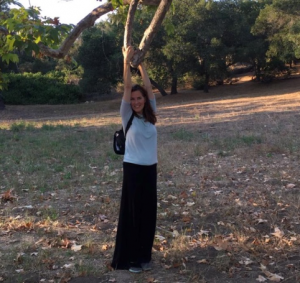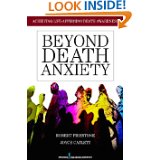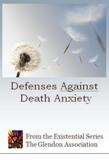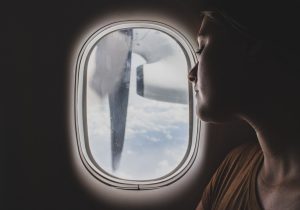The Sweet Spot: Relief from the Fear of Death through Mindfulness
 If you have ever lain awake in the middle of the night pondering death, heart racing, icy hot fear coursing through your body as your mind tries desperately to find solid ground, you are not alone. Let me say that again: You are not alone. On the most basic level, you are not alone, because every other being on the planet shares your fate. That notion probably doesn’t have enough power to alleviate the anxiety though. Thankfully, there are antidotes to our trembling dread of dying, and we can help each other discover them.
If you have ever lain awake in the middle of the night pondering death, heart racing, icy hot fear coursing through your body as your mind tries desperately to find solid ground, you are not alone. Let me say that again: You are not alone. On the most basic level, you are not alone, because every other being on the planet shares your fate. That notion probably doesn’t have enough power to alleviate the anxiety though. Thankfully, there are antidotes to our trembling dread of dying, and we can help each other discover them.
Death is part of life. Many of us would like to ignore that fact, but sooner or later, we can’t. When we lose a friend, a family member, or a cherished pet, we can’t help but think about our own mortality. My friend Andra was diagnosed with a rare, aggressive form of cancer. In terms of scary and dreadful human experiences, this kind of diagnosis is high on the scale for anyone. Sometimes Andra’s mind is highjacked by fear. She gets overwhelmed by the situation, and she feels despair. But sometimes, in the midst of this unwanted development in her life, Andra finds a place inside where the fear dissipates, time stops, the names of diseases and their statistics are irrelevant, and peace fills her mind and body. She has learned how to tap into a sweet spot within that washes her mind and body with calm.
In the United States, we are a death-avoidant culture; we don’t like to talk about death. Perhaps this pervasive avoidance of the subject sets the stage for us to feel alone and alienated when death’s inevitability creeps into our minds. Whether we are religious and we believe in an afterlife or not, death still looms out there as an unknown. It is the ultimate abrogation of control, and losing control is scary for human beings. We would be better off if we could talk about death and share our feelings when we need to.
One night when I was 8 or 9, I found myself in my dark bedroom staring wild-eyed at the ceiling. After some panicked moments alone, trying to wrap my head around my existence, I got out of bed and ran down the hall in search of comfort, “Mom, what happens when you die?” She was watching “The Tonight Show,” and I don’t remember her saying much except to suggest that I ask my dad. With the sound of talk-show banter behind me, I padded down to their bedroom, where my father lay in the dark listening to sports radio. “Dad, what happens when you die?” He kept his eyes closed and patted my hand, “You go to heaven, of course.” A few more pats, but no more words. I lay there quietly for a few minutes with him, listening to the crackling of the game scores then went back to my room alone. They didn’t know. My parents didn’t know how to talk about death, so neither one could be present with me to help me be present with my feelings. I didn’t know how to process the fear, so I tried very hard to bury it. In years to come, bouts of panic and anxiety belied the fact that it was still lurking.
Ideally, when confronting the notion of death, a child will have an adult to turn to, someone who can be physically close, make eye contact, empathize with the feelings, and reassure the child that he or she is safe right now. If you are a parent in this position, you don’t need to have all the answers about life and death. I spoke with Dr. Lisa Firestone, Director of Research and Education for The Glendon Association, who said it’s important to be truthful with kids and not to make things up to take away their fear. Kids know when we are being real. Firestone says “The most important thing is to let kids have their feelings. We can help them regulate their emotions with our care and concern.” Having this kind of emotional support helps kids become resilient, in spite of life’s unanswerable questions. But children aren’t the only ones who fear the vast, menacing concept of death. Plenty of adults grapple with it, too, and sometimes there is no one to connect with when we are afraid. In such moments, we can still feel relief and comfort. Like finding safety in the eye of a storm, there is a way we can be present to the moment and to ourselves that can calm us down and bring peace.
I discovered this oasis of well-being by accident, many years ago during an acute anxiety attack on a plane. We were waiting for take-off, and I was huddled in my window seat in a black hole of sheer terror. My mind was racing, “Oh my god, should I get off the plane? Should I try affirmations? Am I going off the deep end? Can people see that I’m losing it?” My thoughts were swirling in a tornado of panic. In desperation, I turned my attention inward, to my body. I put my hands on my chest and felt the slamming of my heartbeat. The pounding of my racing pulse filled my ears. I concentrated on my breathing and felt heat radiating out from my chest from the adrenaline rushing through. And astonishingly, by connecting with my body for those few seconds, I broke free from the frantic thinking. I found myself spit out of the tornado, simply experiencing the intense physical sensations. I experienced a wave of compassion for myself, vulnerable, scared person that I was, touched my cheek and felt tears of relief rolling down. My breathing slowed, and soon my body was calm. Not only was the anxiety gone, but I felt peaceful and tender-hearted. I smiled at people and had a big reservoir of patience for days. That soft serenity stayed with me for a while. I didn’t have the terminology then, but now I see that I used mindfulness to calm down.
The term “mindfulness” might seem oversaturated, but don’t let that fool you into thinking it is a lightweight fad. Mindfulness is a form of ancient practice with powerful effects. By using simple methods to cultivate our attention and detach from relentless mental chatter, we can enhance our quality of life in all kinds of ways. From practical things like improving sports performance to alleviating anxiety and panic disorders, mindfulness is a free, potent tool available to each one of us.
Does the idea of mindfulness conjure images of rigid discipline? The beauty of mindfulness is that there is no set method. Even stopping to take a deep, slow breath or drink in the fragrance of a flower can be a mini moment of mindfulness. In a 2013 interview for PsychAlive, Mindfulness pioneer and author Jon Kabat Zinn said mindfulness is not a technique, but a way of being. He described mindfulness as “…paying attention, on purpose, in the present moment, non-judgmentally.” He added that what you pay attention to is not so important; it’s the attending that matters (Kabat-Zinn, 2013). In other words, no matter where you are, you have the ability to pay attention to something other than your thoughts. You could focus on the inhales and exhales as you breathe, the feeling of your feet on the ground as you walk, a mantra, or an object in your line of sight. One of my favorite practices is sitting or lying still and focusing on the sensations hitting my ears. It is not the same as “listening” because I am registering the sensations to the ear drums without giving them meaning. In this way, the sound of traffic in the distance or someone starting a lawnmower down the street is a compelling sensation that feels relaxing and helps me drop all my thoughts and concerns. Whatever you choose to attend to, the simple effort of gently bringing your attention to something other than your thoughts (over and over again, because our minds wander, and that’s okay) can have life-altering benefits.
Paradoxically, we can’t use mindfulness to “get rid of” fear. In the book Calming Your Anxious Mind: How Mindfulness and Compassion Can Free You From Anxiety, Fear and Panic, author Jeffrey Brantley writes that mindfulness is “non-judging, non-striving and non-denying” (Brantley, 2003). In other words, wanting the fear to “go away” will keep us stuck in it. Counter-intuitively, it is complete acceptance of what is happening right now that opens the door to freedom. The key is to “be with” the feelings and sensations without getting swept away by thoughts about them.
Neither mindfulness nor death can be successfully explained, only experienced, and there are links below if you would like to begin exploring the ineffable benefits of mindfulness. In the interview “Mindfulness as a Love Affair with Life,” Kabat-Zinn says that the practice helps people “get out of their smallness and start to feel the entirety of themselves, which brings up spirituality” (2015). But you don’t have to believe in any kind of higher power to experience what Kabat-Zinn refers to as “spirituality.” Words like “freedom” or “expansiveness” could just as easily be used. Whatever the language, being wide awake and experiencing gaps in between thoughts, respite from the incessant judging, comparing, planning, and perseverating feels liberating! The mind is a powerful tool, but thinking cannot lead us out of death anxiety, because THINKING about death is usually what makes us anxious. Trying to understand the entirety of life and death from our limited perspective is like trying to see the whole sky by looking through a straw. It’s futile. We are all going to die, but we don’t have to pretend we understand what that means. Why suppose that the energy that animates our bodies ends with death? Science tells us “energy can neither be created nor destroyed” (Moskowitz, 2014). Our journey here is temporary, but why should we assume this is the end of the road? Mindfulness can put some space between our thoughts and assumptions, and in that space, we can create new ways of responding to life (and death).
We know we don’t know what happens when we die. The passionately religious person and the atheist are in the same boat when it comes to death – inexperienced. It’s anybody’s guess, and each one of us gets to choose what we want to imagine about it. I personally take comfort in the millions of Near Death Experiences (NDEs) reported around the world (Scientists Validate, 2016). Whether one believes NDEs are mystical or simply phenomena of the brain as it expires, studies have shown that individuals who experience NDEs go on to love their lives more and fear death less (Groth-Marnat and Summer, 2014). In the book, Dying To Be Me, Anita Moorjani writes a particularly inspiring and well-documented account of her life and near death from cancer (Moorjani, 2012). Now completely recovered, she writes and teaches full time about her experience in what she calls “heaven” (CNN, 2013).
 Here on earth, Andra and I walked through a rose garden recently. We smelled the roses and touched the trees. I marveled at the beauty of her eyes, lit as they were by the pinkish light of the setting sun. Later, we ate soup in her cozy living room, petted her cats, and giggled at the silly teasing of her devoted partner, Laurence. These simple moments, experienced through our senses, were rich and sweet. Timelines were cast aside. Just the experience of contentment and friendship remained.
Here on earth, Andra and I walked through a rose garden recently. We smelled the roses and touched the trees. I marveled at the beauty of her eyes, lit as they were by the pinkish light of the setting sun. Later, we ate soup in her cozy living room, petted her cats, and giggled at the silly teasing of her devoted partner, Laurence. These simple moments, experienced through our senses, were rich and sweet. Timelines were cast aside. Just the experience of contentment and friendship remained.
After months of treatments, Andra has been given excellent news. Her tumor is steadily shrinking. She has more time, and she plans to relish every exquisite moment of it. She doesn’t know how much more time, but none of us knows how long we have. Whether our life will span five more days or five more decades, we have access to deep aliveness right now, through our senses and our feelings, and our ability to bring awareness to the moment just as it is.
Dwelling in the present moment is a very wise choice in this constantly changing world. Everything that looks so solid will eventually be no more, but one moment at a time we can show up and know that our impact on each other is real. Whatever our gifts, when we share them with those who need them, we add to the goodness in the world. The simple practice of mindfulness can help us tolerate feelings that naturally arise when we dare to stay open, to reach for what we want and offer what we have, in spite of all the endings. Uncertainty about what’s coming around the bend does not have to diminish our presence on this earth. Bring what you have while you’re here and know that it matters.
As human beings, we endure some brutally painful things. From the moment we are born, we are guaranteed a death, and in between we’re vulnerable to all kinds of hurt. Yet we keep getting out of bed in the morning and doing our best to feel good. Aren’t the most precious moments in our lives good because of things that can’t be measured? The essence of YOU cannot be defined, or sized up, or contained. The sparkle in your eyes, your sense of humor, the generosity you offer – these can’t be grasped to begin with. So how can we know they dissolve with the body when it dies? We can’t. We simply can’t. Eckhart Tolle puts the mystery of existence succinctly and poetically in his book Stillness Speaks: “Death is not the opposite of life. Life has no opposite. The opposite of death is birth. Life is eternal” (2003).
You are not alone. I wrote this for you. We are all in this together and despite our mortal predicament, we have the precious gift of being able to care about and touch each other. Mindfulness can bring us into the most safe and sacred time and place there is: now and here. This is the sweet spot. May you find yourself here and know peace, my fellow traveler.
Quick Links
Anita Moorjani CNN excerpt (2 minutes): click here
Anita Moorjani’s TEDxBayArea Talk (18 minutes): click here
Anita Moorjani’s story in her own words: click here
Jon Kabat Zinn interview with Dr. Lisa Firestone (Excerpt -5 minutes): click here
Jon Kabat Zinn interview “Mindfulness as a Love Affair with Life” (22 minutes) click here
Jon Kabat Zinn guided meditation (10 minutes): click here
References
Brantley, J. (2003). Calming your anxious mind: How mindfulness and compassion can free you of anxiety, fear and panic. Oakland, CA: New Harbinger.
CNN (Producer). (2013, November 27). A cancer survivor’s experience in heaven [Video file]. Retrieved May 19, 2016, from https://www.youtube.com/watch?v=yK1F0F9_e0o
Kabat-Zinn, P. J. (2013). What is Mindfulness? Retrieved November 28, 2016, from http://devpsych.psychalive.org/what-is-mindfulness/
Groth-Marnat, Gary, and Roger Summer. “Altered beliefs, attitudes, and behaviors following near-death experiences.” The Journal of Humanistic Psychology Summer 1998: 110+. Biography in Context. Web. 19 May 2016.
Moorjani, A. (2012). Dying to be me: My Journey from cancer, to near death, to true healing. United States: Hay House.
Moskowitz, C. (2014, August 5). Fact or Fiction? Energy Can Neither Be Created Nor Destroyed. Scientific American. Retrieved November 22, 2016, from https://www.scientificamerican.com/article/energy-can-neither-be-created-nor-destroyed/
Scientists Validate Near-Death Experiences. (2016, January 8). Retrieved November 21, 2016, from http://abcnews.go.com/GMA/DrJohnson/story?id=126449&page=1
Sounds True (Producer). (2014, October 14). Jon Kabat-Zinn, PhD – Guided mindfulness meditation series 1 [Video file]. Retrieved May 13, 2016, from https://www.youtube.com/watch?v=8HYLyuJZKno
Tolle, E. (2003). Stillness speaks. Vancouver: Namaste Pub.
UMNCSH (Producer). (2015, December 8). Mindfulness as a love affair with life: An interview with Jon Kabat-Zinn [Video file]. Retrieved May 13, 2016, from https://www.youtube.com/watch?v=F2LebuLJmmA
Tags: anxiety, death anxiety, existential, fear, fear of mortality, Life Affirming Death Awareness, mindfulness












Hi. @ Maureen Sullivan your article on The Sweet Spot Relief from the fear of death through mindfulness is beautiful. Most learned myself and by myself is it’s unknown importance to those in places that do and are not able to access your article. I have so many illness that it is a bore to myself and readers to hear over and over. I also have memory problems because of it. I would love to have this article through mail for easy access. I would love to read it to myself repeatedly because I want to or because I forgot as well as read to someone to ill to. I have survive life support 4-6 times. The last time was 10 days. Im disable at 52 and get tired of trying painfully to put my life back in order to fail each time. I’m also on low income that makes life really hard. Those of you healthy at any age, listen, to testimonials. Don’t make your life harder. Your body, mind will pay the price. Be kind to those troubled and suffering. Thanks Maureen Sullivan
This brought me to tears and helped me feel more connected with everyone in this life. Thank you for sharing this. I love Anita Moorjani. I will practice mindfullness more often for relief from my anxiety.mary
I’ve just come across this blog. Thank you. I found it so helpful – and wonderful references too. Beautifully written.